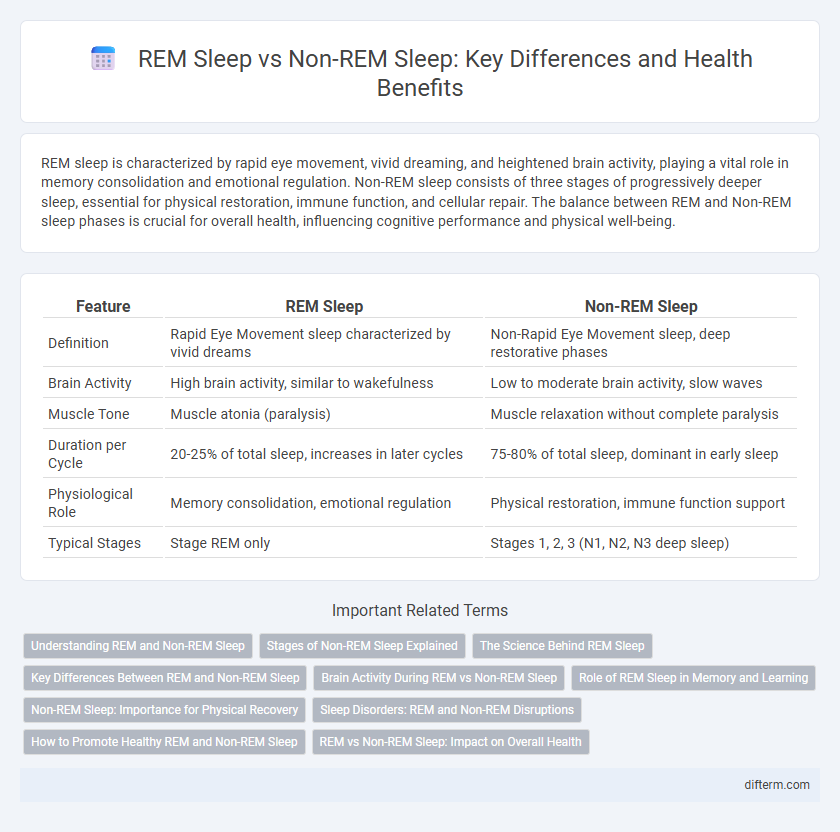REM sleep is characterized by rapid eye movement, vivid dreaming, and heightened brain activity, playing a vital role in memory consolidation and emotional regulation. Non-REM sleep consists of three stages of progressively deeper sleep, essential for physical restoration, immune function, and cellular repair. The balance between REM and Non-REM sleep phases is crucial for overall health, influencing cognitive performance and physical well-being.
Table of Comparison
| Feature | REM Sleep | Non-REM Sleep |
|---|---|---|
| Definition | Rapid Eye Movement sleep characterized by vivid dreams | Non-Rapid Eye Movement sleep, deep restorative phases |
| Brain Activity | High brain activity, similar to wakefulness | Low to moderate brain activity, slow waves |
| Muscle Tone | Muscle atonia (paralysis) | Muscle relaxation without complete paralysis |
| Duration per Cycle | 20-25% of total sleep, increases in later cycles | 75-80% of total sleep, dominant in early sleep |
| Physiological Role | Memory consolidation, emotional regulation | Physical restoration, immune function support |
| Typical Stages | Stage REM only | Stages 1, 2, 3 (N1, N2, N3 deep sleep) |
Understanding REM and Non-REM Sleep
REM sleep, characterized by rapid eye movements and vivid dreaming, plays a vital role in memory consolidation and emotional regulation. Non-REM sleep, consisting of stages 1 through 3, facilitates physical restoration, immune function enhancement, and overall brain recovery. Distinguishing between REM and Non-REM sleep stages is crucial for understanding their specific contributions to cognitive health and physiological balance.
Stages of Non-REM Sleep Explained
Non-REM sleep is divided into three stages: N1, N2, and N3, each characterized by distinct brainwave activity and physiological functions. Stage N1 marks the transition from wakefulness to sleep with light, easily disrupted rest, while Stage N2 constitutes the majority of total sleep time, featuring sleep spindles that play a role in memory consolidation. Stage N3, also known as slow-wave sleep, is the deepest phase crucial for physical restoration, immune function, and growth hormone release.
The Science Behind REM Sleep
REM sleep, characterized by rapid eye movements and heightened brain activity, plays a crucial role in memory consolidation and emotional regulation, supported by increased hippocampal-neocortical communication. Neurotransmitters such as acetylcholine surge during REM, facilitating synaptic plasticity and the processing of complex information. Distinct from non-REM stages, REM sleep features an active brain with muscle atonia, enabling the brain to rehearse and integrate learning without physical movement.
Key Differences Between REM and Non-REM Sleep
REM sleep is characterized by rapid eye movements, vivid dreaming, and increased brain activity similar to wakefulness, playing a crucial role in memory consolidation and emotional processing. Non-REM sleep, comprising stages 1 through 3, features slow-wave brain activity, physical restoration, and immune system strengthening. The key differences lie in brain wave patterns, muscle activity levels--REM sleep exhibits muscle atonia while Non-REM allows movement--and the distinct physiological functions each stage supports for overall health.
Brain Activity During REM vs Non-REM Sleep
Brain activity during REM sleep is characterized by high-frequency, low-amplitude waves similar to wakefulness, promoting intense dreaming and neural processing. In contrast, Non-REM sleep features slower, higher-amplitude brain waves that support physical restoration and memory consolidation. The distinct neural patterns during REM and Non-REM stages reflect their complementary roles in cognitive function and overall brain health.
Role of REM Sleep in Memory and Learning
REM sleep plays a crucial role in memory consolidation and learning by facilitating synaptic plasticity and neural reorganization within the hippocampus. During REM sleep, the brain processes and integrates new information, strengthening procedural and emotional memories. Studies show that disruptions in REM sleep negatively impact cognitive functions, highlighting its importance in skill acquisition and memory retention.
Non-REM Sleep: Importance for Physical Recovery
Non-REM sleep plays a crucial role in physical recovery by promoting muscle repair, tissue growth, and immune system strengthening during deep sleep stages. This phase enables the secretion of growth hormones essential for cell regeneration and overall bodily restoration. Ensuring adequate Non-REM sleep enhances athletic performance, reduces inflammation, and accelerates healing processes.
Sleep Disorders: REM and Non-REM Disruptions
REM sleep disruptions are commonly linked to disorders such as REM Behavior Disorder (RBD), characterized by vivid dreams and physical activity during REM phases, leading to potential injury. Non-REM sleep disturbances, including disorders like sleepwalking and night terrors, primarily occur during deep sleep stages and often affect children more than adults. Both REM and Non-REM sleep disruptions contribute to fragmented sleep, resulting in daytime fatigue, cognitive impairments, and increased risk for chronic conditions like hypertension and depression.
How to Promote Healthy REM and Non-REM Sleep
Maintaining a consistent sleep schedule supports healthy REM and Non-REM sleep cycles by regulating the body's internal clock. Creating a calm sleep environment free from distractions enhances the quality of deep Non-REM sleep and the restorative REM phase. Avoiding caffeine and electronic screens before bedtime helps facilitate natural transitions between sleep stages, promoting overall sleep health.
REM vs Non-REM Sleep: Impact on Overall Health
REM sleep plays a crucial role in memory consolidation, emotional regulation, and brain development, while non-REM sleep primarily supports physical restoration, immune function, and tissue repair. Disruptions in REM sleep have been linked to cognitive impairments and mood disorders, whereas non-REM sleep deficiency is associated with increased inflammation and cardiovascular risks. Balancing both REM and non-REM sleep stages is essential for maintaining optimal mental health, physical recovery, and overall well-being.
REM Sleep vs Non-REM Sleep Infographic

 difterm.com
difterm.com